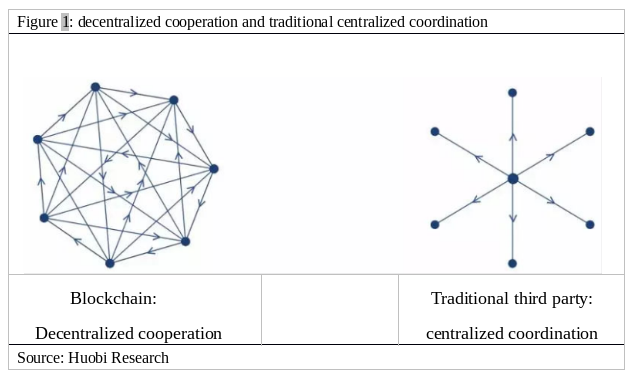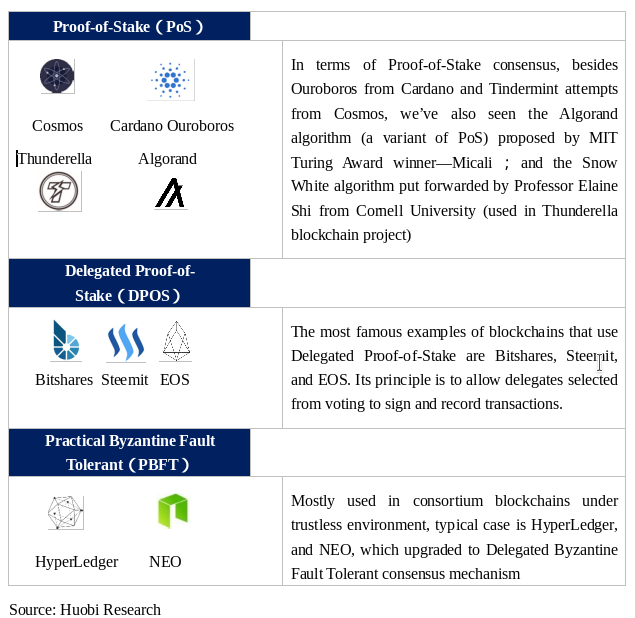Huobi Global Blockchain Technology Overview and Prospects: Trustless Decentralization
Huobi Pro is about to release a “Global Blockchain Industry Overview and Prospects report for the Fiscal first quarter of 2018. The full report will be released at the Blockchain Festival in Ho Chi Minh City Vietnam between May 24th and 25th. I have a sneak peek of the report and would like to share what I consider to be the most interesting parts of the report. This is the second part of four overviews of this report.

Our current form of economic activity depends on the public’s trust in centralized institutions such as banks and lawyers to process transactions and contracts for us. These centralized parties introduce an added layers of security risk and cost to all of the transactions or contracts that we execute. The digital economy is now seeing a paradigm shift away from centralization to trustless decentralization. This trustless decentralization through blockchain goes through three levels of development according to Xiao Feng, vice president of Wanxiang Holdings, initiator of Wanxiang Blockchain Labs and General partner at Fenbushi Capital:
The first stage of a blockchain is the creation of a distributed communications network for peer to peer communications and transmissions in order to facilitate the exchange of information. The internet has spawned many distributed communications networks for file sharing such as Napster, and as the internet grew, the idea of Napster evolved in to what we now know as BitTorrent.
The second stage of a blockchain is the creation of a distributed ledger which records and synchronizes transactions through cryptography. The distributed ledger is created by a set of rules which are defined by mathematical algorithms and coding which allows anyone anywhere to take part in the ledgers creation and eliminates the need for a third party to control the ledger.
The third stage of a blockchain is the decentralized and open economic ecosystem which gives incentives to the public to participate in value creation and sharing. Public users are able to receive payment by completing tasks such as verifying the distibuted ledger though mining, staking, or by uploading content. These examples give people incentive to be a part of the ecosystem in a similar was as if an employer was to pay them for work, however in the case of blockchain there is no central employer. Blockchain technology has now evolved through those 3 stages of development.
This current state of blockchain technology now faces several bottleneck issues which need to be overcome in order to evolve further. The three major issues that need to be addressed are scalability, privacy, and interoperability.
Scalability is the most important and critical obstacle that must be overcome to obtain mass adoption of blockchain technology throughout the world. Currently blockchains are unable to handle the transaction volume that is required for daily global use at the level that we are used to when we use centralized technologies such as credit cards. VISA can currently handle up to 24,000 transactions per second, where the major cryptocurrencies such as Bitcoin and Ethereum can only handle a tiny percentage of that throughput with Bitcoin achieving up to 3 to 4 transactions per second and Ethereum achieving over 20 transactions per second. Both Bitcoin and Ethereum currently use Proof-Of-Work consensus algorithms which are very secure yet very inefficient in processing large amounts of transactions. To process more transactions per second we are seeing a move away from Proof-Of-Work consensus to Proof-of-Stake, Delegated Proof-of-Stake, and Byzantine Fault Tolerance.

In addition to Proof-Of-Stake there are several other solutions to the scalability issue which are: side-chain/state-channel, sharding, sub-chain and layered structure:
Side-chain or state-channels can process multiple transactions off chain and then record one final transaction on-chain with the main chain acting as the final settlement layer. Examples of side-chains in use or development today are the Lightning network for Bitcoin and the Raiden Network for Ethereum.
Sharding divides a blockchain network into many separate, independent areas, called “shards” which are each assigned to a small group of nodes. There are generally two kinds of sharding, transaction sharding and state sharding. Transaction sharding assigns different transactions to different shards to create a parallel processing of transactions. State sharding is similar to transaction sharding but adds in cross-shard communication.
Sub-chain and layered structure allows for the separation of transactions and smart contracts. Traditionally transactions and smart contracts are all executed on the same node(s). Cardano is currently attempting to build such a layered structure which divides the blockchain network into a “Control Layer” and “Settlement Layer”. The settlement layer handles all transactions and the control layer runs smart contracts and decentralized applications.
The second major hurdle that blockchain technology needs to overcome is privacy. Most of the current blockchains today provide pseudonymity, they do not directly show the users identity, yet the transactions and store of values are transparent and are open to anyone who wants to check the public ledger. A few cryptocurrencies can maintain privacy, however they are currently only focused on financial transactions or payments and these technologies have yet to find their way in to more advanced blockchains that incorporate smart-contracts and decentralized applications. The most popular privacy focused blockchains that we know today include Dash, Monero, Zcash and Verge which use CoinJoin, Ringsignatures, ZK-Snarks, and Invisible Internet Project respectively.

The third obstacle which needs to be overcome is interoperability, or cross-chain technology. Blockchain systems can currently be divided in to private blockchains, consortium blockchains and public blockchains. Private and consortium blockchains are more likely to be adopted by businesses and financial institutions, however: 1. digital assets can not be transferred between the three kinds of blockchains; 2. Public blockchains can not communicate with each other. Some of the current proposed solutions for interoperability include: Notary Schemes (Ripple), Relay Technology (Cosmos and Polkadot), Side-chain Technology (Bitcoin’s Rootstock), Hash locking technology (Lightning Network and Raiden Network for Bitcoin and Ethereum Respectively). The most well known example of cross-chain technology in use today is Atomic Swaps which have occurred between various blockchains over the Lightning Network. Bitcoin and Litecoin have had successful cross-chain Atomic Swaps (trades).
The information that I have been given to share came from the fourth part of four parts of the “Global Blockchain Industry Overview and Prospects” by www.huobi.pro. The full report will be made available exclusively to attendees of the Blockchain festival Vietnam in Ho Chi Minh City Vietnam. If you would like to attend the festival you can obtain tickets for 50% off the cost with promotional code “WRITE50”. Please visit www.blockchainfestival.com to learn more and to get tickets. To trade new tokens you can visit www.hadax.com which is operated by Huobi Pro and is where newly listed tokens can be traded and voted on for listing.
Congratulations @cryptomined! You have received a personal award!
Click on the badge to view your Board of Honor.
Do not miss the last post from @steemitboard:
Congratulations @cryptomined! You received a personal award!
You can view your badges on your Steem Board and compare to others on the Steem Ranking
Vote for @Steemitboard as a witness to get one more award and increased upvotes!